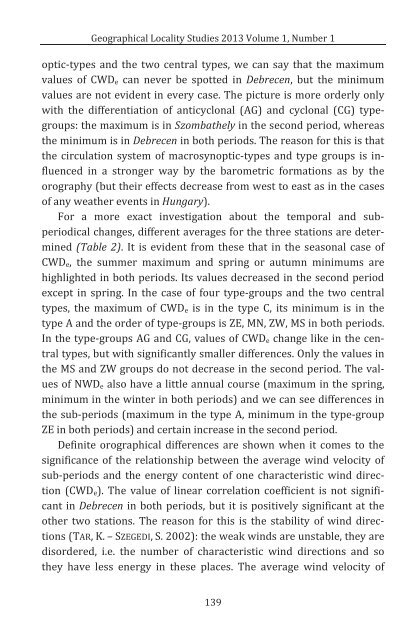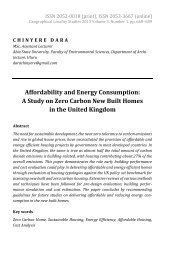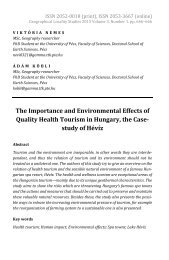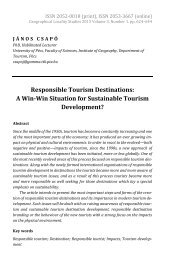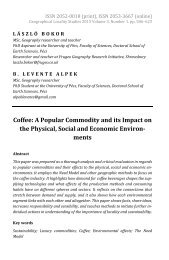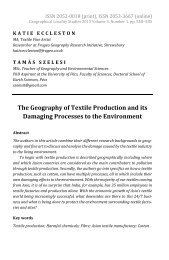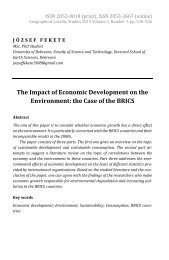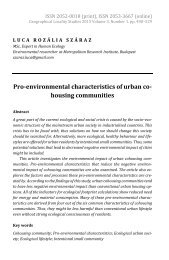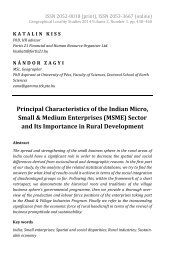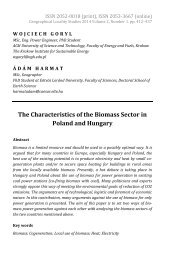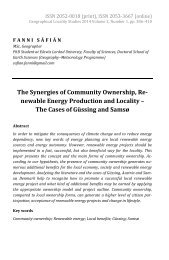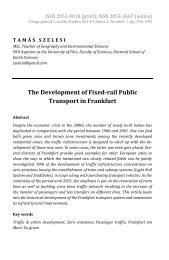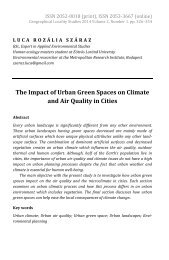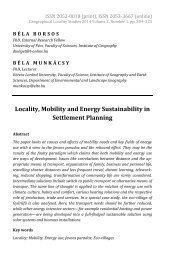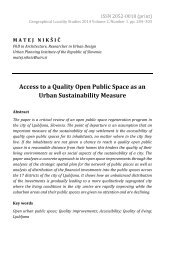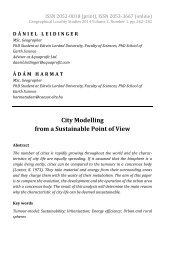Károly Tar: Energetic Parameters of the Wind Directions
The objective of this study is to assess whether changes in the surface pressure field over Europe are reflected in the statistical structure and the inner definiteness of the wind energy (relative frequency, relative energy content, mean velocity, etc.) field over Hungary, despite the country’s specific pressure field.
The objective of this study is to assess whether changes in the surface pressure field over Europe are reflected in the statistical structure and the inner definiteness of the wind energy (relative frequency, relative energy content, mean velocity, etc.) field over Hungary, despite the country’s specific pressure field.
You also want an ePaper? Increase the reach of your titles
YUMPU automatically turns print PDFs into web optimized ePapers that Google loves.
Geographical Locality Studies 2013 Volume 1, Number 1<br />
optic-types and <strong>the</strong> two central types, we can say that <strong>the</strong> maximum<br />
values <strong>of</strong> CWD e can never be spotted in Debrecen, but <strong>the</strong> minimum<br />
values are not evident in every case. The picture is more orderly only<br />
with <strong>the</strong> differentiation <strong>of</strong> anticyclonal (AG) and cyclonal (CG) typegroups:<br />
<strong>the</strong> maximum is in Szomba<strong>the</strong>ly in <strong>the</strong> second period, whereas<br />
<strong>the</strong> minimum is in Debrecen in both periods. The reason for this is that<br />
<strong>the</strong> circulation system <strong>of</strong> macrosynoptic-types and type groups is influenced<br />
in a stronger way by <strong>the</strong> barometric formations as by <strong>the</strong><br />
orography (but <strong>the</strong>ir effects decrease from west to east as in <strong>the</strong> cases<br />
<strong>of</strong> any wea<strong>the</strong>r events in Hungary).<br />
For a more exact investigation about <strong>the</strong> temporal and subperiodical<br />
changes, different averages for <strong>the</strong> three stations are determined<br />
(Table 2). It is evident from <strong>the</strong>se that in <strong>the</strong> seasonal case <strong>of</strong><br />
CWD e , <strong>the</strong> summer maximum and spring or autumn minimums are<br />
highlighted in both periods. Its values decreased in <strong>the</strong> second period<br />
except in spring. In <strong>the</strong> case <strong>of</strong> four type-groups and <strong>the</strong> two central<br />
types, <strong>the</strong> maximum <strong>of</strong> CWD e is in <strong>the</strong> type C, its minimum is in <strong>the</strong><br />
type A and <strong>the</strong> order <strong>of</strong> type-groups is ZE, MN, ZW, MS in both periods.<br />
In <strong>the</strong> type-groups AG and CG, values <strong>of</strong> CWD e change like in <strong>the</strong> central<br />
types, but with significantly smaller differences. Only <strong>the</strong> values in<br />
<strong>the</strong> MS and ZW groups do not decrease in <strong>the</strong> second period. The values<br />
<strong>of</strong> NWD e also have a little annual course (maximum in <strong>the</strong> spring,<br />
minimum in <strong>the</strong> winter in both periods) and we can see differences in<br />
<strong>the</strong> sub-periods (maximum in <strong>the</strong> type A, minimum in <strong>the</strong> type-group<br />
ZE in both periods) and certain increase in <strong>the</strong> second period.<br />
Definite orographical differences are shown when it comes to <strong>the</strong><br />
significance <strong>of</strong> <strong>the</strong> relationship between <strong>the</strong> average wind velocity <strong>of</strong><br />
sub-periods and <strong>the</strong> energy content <strong>of</strong> one characteristic wind direction<br />
(CWD e ). The value <strong>of</strong> linear correlation coefficient is not significant<br />
in Debrecen in both periods, but it is positively significant at <strong>the</strong><br />
o<strong>the</strong>r two stations. The reason for this is <strong>the</strong> stability <strong>of</strong> wind directions<br />
(TAR, K. – SZEGEDI, S. 2002): <strong>the</strong> weak winds are unstable, <strong>the</strong>y are<br />
disordered, i.e. <strong>the</strong> number <strong>of</strong> characteristic wind directions and so<br />
<strong>the</strong>y have less energy in <strong>the</strong>se places. The average wind velocity <strong>of</strong><br />
139


